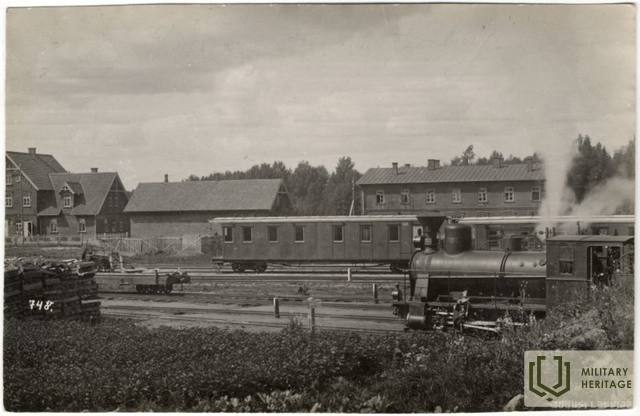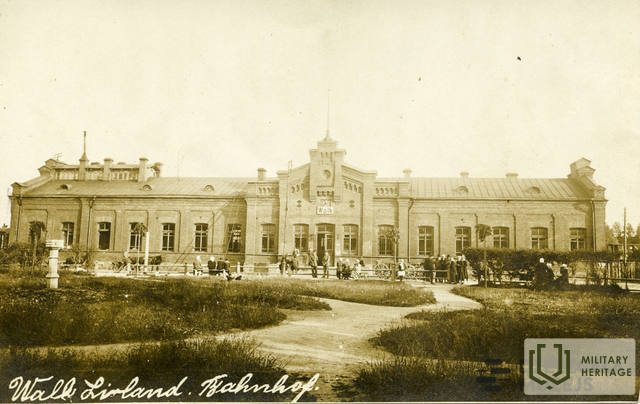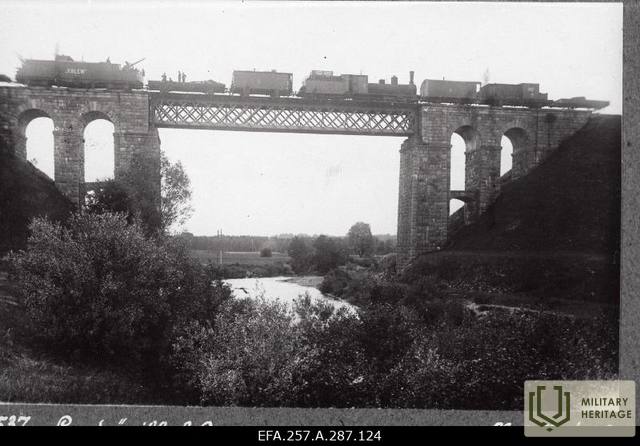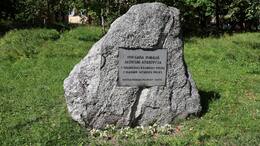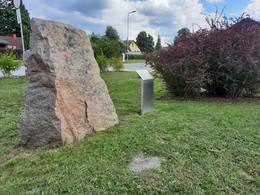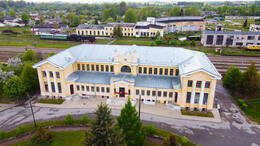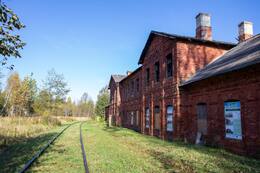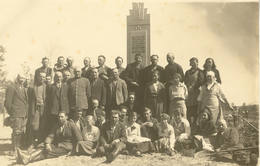Apie Latvijos Nepriklausomybės karą ir 1919 m. įvykius Alūksnėje
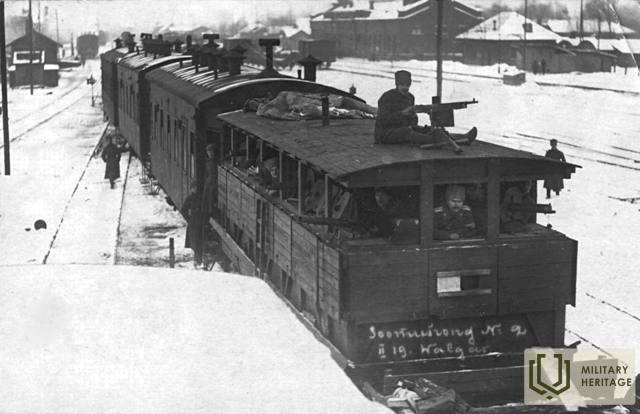
1919 m. kovo 27 d. 1-asis Valmieros pėstininkų pulkas kartu su Talino (tuometinio Rėvelės) ir Tērbato Estijos gvardijos (kaitselit) batalionais bei trimis šarvuočiais traukiniais pradėjo Latvijos išlaisvinimą nuo bolševikų nuo Melnupės upės krantų.
„Laisvės kovų metu siaurasis geležinkelis Gulbene–Valka buvo perduotas Estijos kariuomenės žinion. Jis buvo naudojamas tik kariniams tikslams, įskaitant šarvuotų traukinių judėjimą.“
Šarvuotieji traukiniai buvo puikiai aprūpinti: ginkluoti dviem mažo kalibro pabūklais, 8 kulkosvaidžiais, šautuvais, juos sudarė iki 15 vagonų. Buvo desantinių vienetų, iki 200 žmonių. Traukinį „tempė“ du nauji amerikietiški lokomotyvai.
Matsono prisiminimai. Alūksnės muziejaus kolekcija. ANM 2387.
Alūksnės muziejaus 1965 m. lapkričio 21 d. užfiksuota prisiminimų istorija.
Susijusi laiko juosta
Susijusios temos
Susijusios vietos
Atminimo akmuo Alūksnės išvaduotojams
Įsikūręs Alūksnėje, Helēnas ir Alsviķu gatvių sankirtoje.
Atminimo akmuo buvo atidengtas 1999 m. gegužės 29 d., minint Alūksnės išvadavimo 80-ąsias metines. Akmens drožybos darbus atliko skulptorius Ainārs Zelčs.
1919 m. kovo 31 d. Tartu mieste buvo įkurta Šiaurės Latvijos brigada, kurios užduotis buvo išlaisvinti Vidžemę ir Latgalą. Brigadą sudarė jungtinis 1-asis Valmieros ir 2-asis Cėsių pėstininkų pulkai, vėliau ir Šiaurės Latvijos partizanų pulkas, du kavalerijos eskadrilės ir dvi artilerijos baterijos. Gegužės 26 d. šios pajėgos užėmė Valmierą, tačiau gegužės 27 d. 1-asis Valmieros pėstininkų pulkas kartu su 2-uoju Estijos kavalerijos pulku pradėjo puolimą Alūksnės kryptimi. Bolševikai nesugebėjo atremti tolesnių atakų, todėl 1919 m. gegužės 29 d. Alūksnė buvo išlaisvinta.
Atminimo akmuo suomių savanorių pulkui „Šiaurės berniukai“
Įsikūręs Alūksnėje, Jāņkalna gatvėje 52, šalia Alūksnės siaurojo geležinkelio stoties.
2019 m. vasario 23 d., minint Latvijos Nepriklausomybės karo šimtmetį, Nepriklausomybės kovos tradicijų asociacijos (Suomija) iniciatyva buvo sukurta speciali atminimo vieta Suomijos savanoriams, žuvusiems už Latvijos nepriklausomybę, pagerbti, kurioje istorinius įvykius liudija specialus riedulys ir informacinė lenta. Atminimo akmuo į Alūksnę atkeliavo iš Suomijos – Salpos linijos, kuri buvo nutiesta 1940–1944 m., siekiant apsaugoti rytinę Suomijos sieną. 1200 km ilgio Salpos linija yra viena žymiausių nepriklausomos Suomijos gynybos linijų, taip pat vienas stipriausių ir geriausiai išsilaikiusių tokio tipo gynybos statinių Europoje po Antrojo pasaulinio karo.
Į Alūksnę atgabentas akmuo simbolizuoja dviejų tautų – suomių ir latvių – kovą už savo nepriklausomybę. Suomijos savanorių pulkas „Šiaurės berniukai“ išvyko padėti latviams ginti naujosios Latvijos valstybės laisvę. 1919 m. vasario 21 d. „Šiaurės berniukai“ dalyvavo įnirtingose kovose Alūksnės (Marienburgo) apylinkėse. Po penkias valandas trukusių mūšių netoli Alūksnės geležinkelio stoties suomiai užėmė Alūksnę. Šiame mūšyje žuvo 23 suomių savanoriai, daugelis buvo sužeisti.
Gulbenės geležinkelio stotis
Gulbenės geležinkelio stotis yra Gulbenės mieste. Pirmojo pasaulinio karo metu, 1916–1917 m., siaurojo geležinkelio linija į Pliaviņas buvo rekonstruota iki 1524 mm pločio, kad galėtų būti sujungta su Rygos–Daugpilio linija. Be to, buvo nutiesta geležinkelio linija į Ierikius ir Sitą, taip užtikrinant susisiekimą su Pytalovu. Dėl to Gulbenė tapo geležinkelio mazgu. Dabartinis stoties pastatas, kurį suprojektavo architektas Pēteris Federsas, buvo pastatytas 1926 m. Nepriklausomybės kovų metu, 1919 m. gegužės 31 d., kai Gulbenė buvo išlaisvinta iš bolševikų, 1-asis (4-asis) Valmieros pėstininkų pulkas čia surinko nemažą kiekį karo trofėjų. 1941 m. birželio 14 d. iš Gulbenės geležinkelio stoties buvo deportuoti tiek civiliai gyventojai, tiek Latvijos armijos karininkai, suimti Litenės vasaros stovykloje. Būdamas svarbiu mazgu, jis buvo subombarduotas 1944 m. pavasarį. Po karo jis buvo atkurtas į pradinę formą. 2018 m. atidarytas edukacinis ir interaktyvus centras pavadinimu „Geležinkelis ir garas“. Šalia Gulbenės stoties yra bendrovė SIA „Gulbenes – Alūksnes bānītis“, siūlanti interaktyvias pamokas ir ekskursijas. Lankytojai gali apžiūrėti stoties pastatą ir platformą, atminimo lentą ir skulptoriaus Indulio Rankos sukurtą paminklą represuotiems.
Valkos traukinių stotis
Valkos geležinkelio stotis yra Porukos gatvės gale, šalia nenaudojamų geležinkelio bėgių. Stoties pastatą galima apžiūrėti tik iš išorės, kur yra informaciniai stendai apie geležinkelio svarbą Valkoje ir Valgoje. Šalia stoties pastato yra atminimo akmuo, skirtas 1941 m. birželio 14 d. į Sibirą ištremtiems žmonėms. Stoties pastatas buvo pastatytas apie 1896–1897 m. Iš pradžių čia buvo nutiestos siaurojo geležinkelio linijos Valkos-Rūjienos-Pernu ruože. Pirmojo pasaulinio karo metu geležinkelis buvo smarkiai apgadintas. Nustačius valstybės sieną, Valkos geležinkelio stotis (Valka II) tapo pasienio stotimi. 1920 m. rugsėjo pabaigoje į Valką atvyko speciali Geležinkelių valdybos komisija. Komisija buvo įgaliota derėtis ir sudaryti sutartį su Estija dėl keleivių perkėlimo iš vienos valstybės stoties į kitą. Trikampiu išdėstytų Lugažių, Valkos ir Valgos stočių bėgiai buvo strategiškai svarbūs, nes leido šarvuotiems traukiniams apsisukti ir judėti priešinga kryptimi. Sovietmečiu SSRS armija naudojo šią stotį balistinėms raketoms Valkai pristatyti. 1941 m. birželio 13–14 d. naktį įvyko masinis Latvijos gyventojų deportavimas į SSRS gilumą. Daugiau nei 90 žmonių iš Valkos ir aplinkinių vietovių buvo susodinti į gyvulių vagonus ir deportuoti iš Valkos geležinkelio stoties be jokio teismo sprendimo, išankstinio įspėjimo ar paaiškinimų. 1944 m. rugsėjį stotį sunaikino besitraukianti vokiečių armija.
Paminklas Onos parapijos kariams, žuvusiems Pirmajame pasauliniame kare ir Latvijos išsivadavimo kare
Įsikūręs Anos parapijos Ezerinių kapinių centrinėje dalyje.
Kapinėse, kuriose laidojami nuo 1925 m., stovi paminklas, pastatytas iš Anos parapijos Sargybos skyriaus surinktų lėšomis ir 1933 m. atidengtas, skirtas Anos parapijos kariams, žuvusiems Pirmajame pasauliniame kare ir Latvijos išsivadavimo kare. Iki Antrojo pasaulinio karo paminklo priežiūra rūpinosi Anos parapijos sargybiniai, kurie kiekvieną sekmadienį eidavo į kapines ir, pagerbdami žuvusiuosius, dėdavo gėlių. 1940 m. lapkričio 18 d. paminklas buvo nugriautas, kulkų palikti pėdsakai vis dar matomi. Šiomis dienomis kapinėse kasmet rengiami Lačplėsio dienai skirti minėjimai.
2004 m. kapinėse atidaryta atminimo vieta 1941 ir 1949 m. politiškai represuotiems asmenims, o 2006 m. – atminimo lenta nacionaliniams partizanams.




